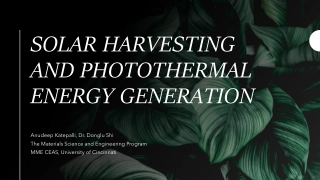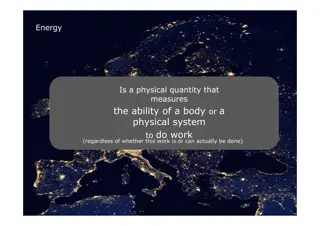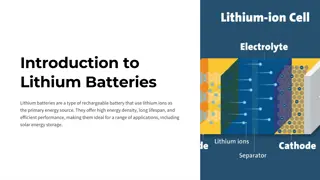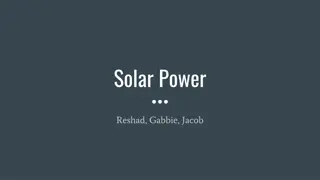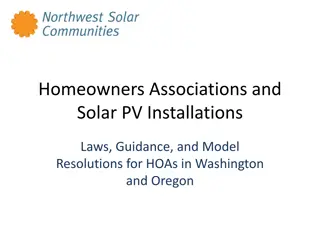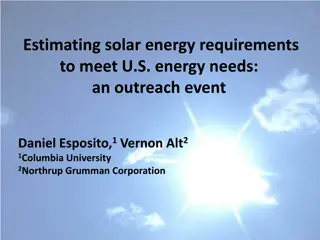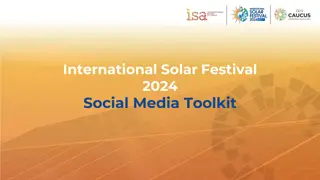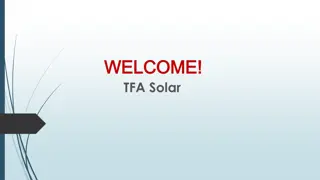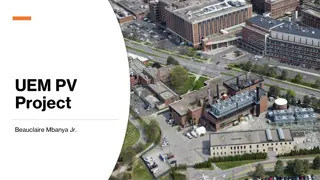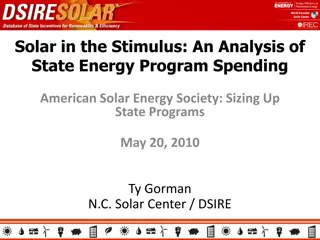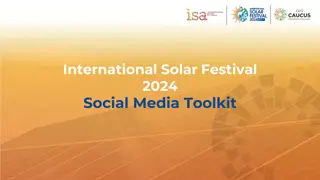
Innovations in Solar Power Satellite Technology: A Comprehensive Overview
Explore the history and advancements in solar power satellite technology from the pioneering work of Nikola Tesla to modern-day developments. Learn about the potential of transmitting power via microwaves from space to Earth and the advantages over traditional solar power solutions. Dive into current designs, legal considerations, and the future potential of solar power satellites.
Download Presentation

Please find below an Image/Link to download the presentation.
The content on the website is provided AS IS for your information and personal use only. It may not be sold, licensed, or shared on other websites without obtaining consent from the author. If you encounter any issues during the download, it is possible that the publisher has removed the file from their server.
You are allowed to download the files provided on this website for personal or commercial use, subject to the condition that they are used lawfully. All files are the property of their respective owners.
The content on the website is provided AS IS for your information and personal use only. It may not be sold, licensed, or shared on other websites without obtaining consent from the author.
E N D
Presentation Transcript
Outline Background Solar Power Satellite Microwave Power Transmission Current Designs Legal Issues Conclusion
Nikola Tesla 1856-1943 Innovations: Alternating current Wireless power transmission experiments at Wardenclyffe
Wardenclyffe 1899 Able to light lamps over 25 miles away without using wires High frequency current, of a Tesla coil, could light lamps filled with gas (like neon)
1940s to Present World War II developed ability to convert energy to microwaves using a magnetron, no method for converting microwaves back to electricity 1964 William C. Brown demonstrated a rectenna which could convert microwave power to electricity
Brief History of Solar Power 1940-50 s Development of the Photovoltaic cell 1958 First US Satellite that used Solar Power 1970 s Oil embargo brought increased interest and study
Solar Power from Satellites 1968 s idea for Solar Power Satellites proposed by Peter Glaser Would use microwaves to transmit power to Earth from Solar Powered Satellites Idea gained momentum during the Oil Crises of 1970 s, but after prices stabilized idea was dropped US Department of Energy research program 1978-1981
Details of the DOE Study Construct the satellites in space Each SPS would have 400 million solar cells Use the Space Shuttle to get pieces to a low orbit station Tow pieces to the assembly point using a purpose built space tug (similar to space shuttle)
Advantages over Earth based solar power More intense sunlight In geosynchronous orbit, 36,000 km (22,369 miles) an SPS would be illuminated over 99% of the time No need for costly storage devices for when the sun is not in view Only a few days at spring and fall equinox would the satellite be in shadow
Continued Waste heat is radiated back into space Power can be beamed to the location where it is needed, don t have to invest in as large a grid No air or water pollution is created during generation
Problems Issues identified during the DOE study Complexity 30 years to complete Size 6.5 miles long by 3.3 miles wide Transmitting antenna mile in diameter(1 km)
Continued Cost prototype would have cost $74 billion Microwave transmission Interference with other electronic devices Health and environmental effects
1980s to Present Japanese continued to study the idea of SPS throughout the 1980 s In 1995 NASA began a Fresh Look Study Set up a research, technology, and investment schedule
NASA Fresh Look Report SPS could be competitive with other energy sources and deserves further study Research aimed at an SPS system of 250 MW Would cost around $10 billion and take 20 years National Research Council found the research worthwhile but under funded to achieve its goals
Specifications Collector area must be between 50 (19 sq miles) and 150 square kilometers (57 sq miles) 50 Tons of material Current rates on the Space Shuttle run between $3500 and $5000 per pound 50 tons (112,000lbs)=$392,000,000
Continued There are advantages Possible power generation of 5 to 10 gigawatts If the largest conceivable space power station were built and operated 24 hours a day all year round, it could produce the equivalent output of ten 1 million kilowatt-class nuclear power stations.
Deployment Issues Cost of transporting materials into space Construction of satellite Space Walks Maintenance Routine Meteor impacts
Possible Solutions International Space Station President s plan for a return to the moon Either could be used as a base for construction activities
From the Satellite Solar power from the satellite is sent to Earth using a microwave transmitter Received at a rectenna located on Earth Recent developments suggest that power could be sent to Earth using a laser
Microwaves Frequency 2.45 GHz microwave beam Retro directive beam control capability Power level is well below international safety standard
Microwave vs. Laser Transmission Microwave Laser More developed Recently developed solid state lasers allow efficient transfer of power High efficiency up to 85% Beams is far below the lethal levels of concentration even for a prolonged exposure Range of 10% to 20% efficiency within a few years Conform to limits on eye and skin damage Cause interference with satellite communication industry
Rectenna An antenna comprising a mesh of dipoles and diodes for absorbing microwave energy from a transmitter and converting it into electric power. Microwaves are received with about 85% efficiency Around 5km across (3.1 miles) 95% of the beam will fall on the rectenna
Rectenna Design Currently there are two different design types being looked at Wire mesh reflector Built on a rigid frame above the ground Visually transparent so that it would not interfere with plant life Magic carpet Material pegged to the ground
5,000 MW Receiving Station (Rectenna). This station is about a mile and a half long.
Rectenna Issues Size Miles across Location Aesthetic Near population center Health and environmental side effects Although claim that microwaves or lasers would be safe, how do you convince people
Details Project in Development in Japan Goal is to build a low cost demonstration model by 2025 8 Countries along the equator have agreed to be the site of a rectenna
Continued 10 MW satellite delivering microwave power Will not be in geosynchronous orbit, instead low orbit 1100 km (683 miles) Much cheaper to put a satellite in low orbit 200 seconds of power on each pass over rectenna
Power to Mobile Devices If microwave beams carrying power could be beamed uniformly over the earth they could power cell phones Biggest problem is that the antenna would have to be 25-30 cm square
Low Orbit Communications industry proposing to have hundreds of satellites in low earth orbit These satellites will use microwaves to beam communications to the ground Could also be used to beam power
Continued Since a low orbit microwave beam would spread less, the ground based rectenna could be smaller Would allow collectors on the ground of a few hundred meters across instead of 10 kilometers In low orbit they circle the Earth in about every 90 minutes
Issues Would require a network of hundreds of satellites Air Force currently track 8500 man made objects in space, 7% satellites Would make telecommunications companies into power companies
Reliability Ground based solar only works during clear days, and must have storage for night Power can be beamed to the location where it is needed, don t have to invest in as large a grid A network of low orbit satellites could provide power to almost any point on Earth continuously because one satellite would always be in range
Legal Issues Who will oversee? Environmental Concerns International
NASA Funding the research In charge of space flight for the United States Would be launching the satellites and doing maintenance
FCC Federal Communications Commission The FCC was established by the Communications Act of 1934 and is charged with regulating interstate and international communications by radio, television, wire, satellite and cable.
Environmental Possible health hazards Effects of long term exposure Exposure is equal to the amount that people receive from cell phones and microwaves Location The size of construction for the rectennas is massive
International Geosynchronous satellites would take up large sections of space Interference with communication satellites Low orbit satellites would require agreements about rectenna locations and flight paths
Conclusions More reliable than ground based solar power In order for SPS to become a reality it several things have to happen: Government support Cheaper launch prices Involvement of the private sector


